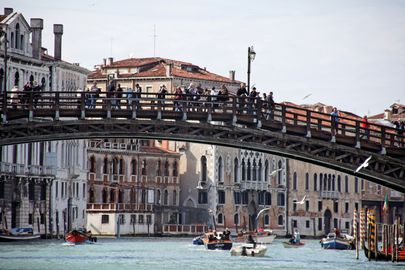

The first bridge to be constructed over the Grand Canal was the Ponte di Rialto - first a wooden one in the 13th century, and then the stone structure that we see today, at the end of the 16th century. As soon as stone bridge went up, Venetians began talking about constructing two more bridges, one at the beginning of the canal, by today's train station, and one at the end of the canal, somewhere by the Punta della Dogana. However, it was not until the 19th century that these plans actually began taking shape.
In 1838, during the Austrian occupation, Giuseppe Salvadori proposed constructing a tunnel under the canal so as not to create problems for the passing vessels. Yet, his idea was soon abandoned, not only because it was technically risky, but also because a strong anti-Austrian sentiment was sweeping across Venice, leading to the revolt of 1848.
5 years later the city's authorities returned to the idea of the bridge and approached Austrian engineer Alfred Neville, who had already built 37 iron suspension bridges in other European countries. Two years later Neville constructed the first bridge on the site of today's Accademia Bridge. Pedestrians had to pay a toll. It was called the Ponte della Carita, in honor of the ex-confraternity building that housed the Fine Arts Academy. Neville also built an analogous structure on the spot where today lies the Scalzi Bridge. The Venetians, however, did not particularly appreciate the two bridges. First, their industrial style clashed with the sumptuous palaces on both sides of the canal, and second, they were not high enough for certain vessels to pass. Also, after only seventy years the bridges began to corrode and were considered dangerous.
In 1932 two architects, Torres and Briazza, won the competition for the construction of the new stone Carita Bridge. While they were going about planning the construction, Eugenio Miozzi, in just 37 days, built a temporary wooden bridge, which was opened to the public in February 1933. It was the largest wooden arch bridge in Europe. The Venetians liked it so much that they no longer wanted the stone bridge and decided to leave Miozzi's wooden structure. From then on it became know as the Accademia Bridge.
In 1986 the long wooden part of the bridge was substituted with new, more resistant pieces, and the wooden arches were replaced with iron ones. The bridge blends perfectly with the waterscape: it is not heavy like the Rialto Bridge; it has an old-fashioned look, though it is one of the most recent bridges to be built over the Grand Canal; and it possesses a romantic element with its gorgeous view of the Church of Santa Maria della Salute. No wonder couples passing through Venice today leave their love padlocks on it. And so far, there have not been any signs prohibiting people from throwing the keys into the water.